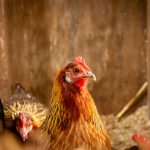Chickens have specific requirements for their well-being, particularly during winter. Providing a warm, dry environment is essential to protect them from cold and damp conditions. Fresh water must be available to prevent dehydration, as water sources may freeze.
Proper ventilation is crucial to avoid the accumulation of harmful gases and moisture in their living space. Chickens are more vulnerable to cold temperatures than mammals due to their limited ability to regulate body temperature. Their shelter should be well-insulated and draft-free to maintain warmth.
A dry, clean living area is necessary to prevent frostbite and respiratory issues. Understanding and meeting these needs is vital for maintaining the health and comfort of chickens during winter. Proper care and attention to their specific requirements will help ensure the flock thrives in colder weather conditions.
Table of Contents
- 1 Providing adequate shelter and insulation
- 2 Ensuring proper ventilation
- 3 Utilizing heat sources safely
- 4 Offering warm bedding and nesting materials
- 5 Providing access to fresh water
- 6 Monitoring and adjusting as needed
- 7 FAQs
- 7.1 What are the best ways to keep live chickens warm in the winter time?
- 7.2 How can I insulate my chicken coop to keep it warm in the winter?
- 7.3 Is it safe to use heat lamps or heaters in the chicken coop?
- 7.4 What type of bedding should I use to keep my chickens warm in the winter?
- 7.5 How can I ensure good ventilation in the chicken coop while keeping it warm?
Key Takeaways
- Chickens need extra care in winter due to their susceptibility to cold temperatures
- Adequate shelter and insulation are essential to protect chickens from harsh weather conditions
- Proper ventilation is crucial to prevent moisture buildup and maintain air quality in the coop
- Heat sources should be used carefully to avoid fire hazards and burns to the chickens
- Providing warm bedding and nesting materials helps chickens stay comfortable and retain body heat
- Access to fresh water is important for chickens to stay hydrated and maintain their health
- Regular monitoring and adjustments are necessary to ensure the well-being of chickens in winter
Providing adequate shelter and insulation
Insulation is Key
First and foremost, it’s important to ensure that the chicken coop is well-insulated to keep the cold out and the warmth in. This can be achieved by using materials such as straw, hay, or wood shavings to create a thick layer of bedding on the floor of the coop.
Sealing Drafts and Gaps
Additionally, adding extra insulation to the walls and roof of the coop can help to maintain a comfortable temperature inside. It’s also important to seal any drafts or gaps in the coop to prevent cold air from entering and warm air from escaping.
Maintaining a Dry Environment
In addition to insulation, providing adequate shelter for chickens in winter also means ensuring that their living space is dry and free from moisture. This can be achieved by regularly cleaning out the coop and replacing soiled bedding with fresh, dry material. It’s also important to provide proper drainage around the coop to prevent water from pooling and creating damp conditions.
By taking these steps to provide adequate shelter and insulation, you can help to create a comfortable and safe environment for your chickens to thrive in during the winter months.
Ensuring proper ventilation

While it’s important to keep chickens warm and protected from the cold in winter, it’s equally important to ensure that their living space is properly ventilated. Proper ventilation is essential for maintaining good air quality and preventing the buildup of harmful gases such as ammonia, which can be detrimental to the health of chickens. In winter, it’s common for chicken coops to become more tightly sealed in an effort to keep out the cold, but this can also lead to poor ventilation if not managed properly.
To ensure proper ventilation in the chicken coop during winter, it’s important to provide adequate airflow without creating drafts that could make the chickens uncomfortable. This can be achieved by installing vents or windows that can be opened and closed as needed to regulate airflow. It’s also important to regularly clean out the coop to remove any buildup of waste or soiled bedding that could contribute to poor air quality.
By ensuring proper ventilation in the chicken coop, you can help to create a healthy and comfortable environment for your flock to thrive in during the winter months.
Utilizing heat sources safely
In some cases, providing additional heat sources may be necessary to keep chickens warm during particularly cold spells in winter. However, it’s important to use heat sources safely to prevent the risk of fire or injury to the chickens. When using heat lamps or other heating devices in the chicken coop, it’s crucial to ensure that they are securely installed and positioned away from any flammable materials such as bedding or nesting material.
It’s also important to regularly check heating devices for any signs of wear or damage that could pose a safety hazard. Another important consideration when using heat sources in the chicken coop is to provide backup power sources in case of a power outage. This can be achieved by using a generator or battery-powered heat lamps to ensure that the chickens remain warm even if there is a loss of electricity.
By utilizing heat sources safely and responsibly, you can help to keep your chickens warm and comfortable without compromising their safety.
Offering warm bedding and nesting materials
Providing warm bedding and nesting materials is essential for keeping chickens comfortable and protected from the cold in winter. This can be achieved by using materials such as straw, hay, or wood shavings to create a thick layer of bedding on the floor of the coop. Additionally, providing nesting boxes filled with soft, insulating materials such as straw or shredded paper can help to keep eggs warm and prevent them from freezing in cold weather.
It’s also important to regularly clean out soiled bedding and replace it with fresh, dry material to maintain a clean and comfortable living space for the chickens. By offering warm bedding and nesting materials, you can help to create a cozy environment for your flock to rest and stay warm during the winter months.
Providing access to fresh water

Preventing Dehydration
Access to fresh water is crucial for chickens in winter, as dehydration can be a serious issue when water sources freeze over. To ensure that chickens have access to water at all times, it’s important to regularly check water containers for ice and replace them with fresh water as needed.
Keeping Water from Freezing
Additionally, using heated waterers or adding insulation around water containers can help to prevent them from freezing in cold temperatures.
Monitoring Water Consumption
It’s also important to monitor water consumption closely during winter, as chickens may drink more water than usual in an effort to stay warm. By providing access to fresh water and taking steps to prevent it from freezing, you can help to ensure that your chickens remain hydrated and healthy throughout the winter months.
Monitoring and adjusting as needed
Finally, it’s important to monitor your chickens closely during winter and make any necessary adjustments to their living space or care routine as needed. This can include checking for signs of cold stress such as shivering or huddling together for warmth, as well as monitoring water consumption and egg production. If necessary, you may need to make changes such as adding additional insulation, adjusting ventilation, or providing supplemental heat sources to keep your chickens comfortable and healthy.
By staying vigilant and responsive to your chickens’ needs, you can help to ensure that they remain happy and healthy throughout the winter months. Regularly assessing their living conditions and making adjustments as needed will help you provide the best possible care for your flock during this challenging time of year.
If you’re looking for tips on how to keep live chickens warm in the winter time, you may also be interested in learning about duck mating season. Understanding the natural breeding patterns of ducks can help you better care for your flock during the colder months. Check out this article on duck mating season to learn more about how to support your ducks during this time.
FAQs
What are the best ways to keep live chickens warm in the winter time?
Some of the best ways to keep live chickens warm in the winter time include providing a well-insulated coop, using heat lamps or heaters, providing extra bedding, and ensuring good ventilation.
How can I insulate my chicken coop to keep it warm in the winter?
You can insulate your chicken coop by using materials such as straw bales, foam insulation, or reflective insulation. It’s important to insulate the walls, ceiling, and floor of the coop to keep the warmth in and the cold out.
Is it safe to use heat lamps or heaters in the chicken coop?
It is safe to use heat lamps or heaters in the chicken coop as long as they are installed properly and used according to the manufacturer’s instructions. It’s important to keep them away from flammable materials and to use a thermostat to regulate the temperature.
What type of bedding should I use to keep my chickens warm in the winter?
In the winter, it’s best to use deep bedding such as straw, hay, or wood shavings to provide insulation and warmth for the chickens. Make sure to regularly clean and replace the bedding to keep it dry and free from mold.
How can I ensure good ventilation in the chicken coop while keeping it warm?
You can ensure good ventilation in the chicken coop by installing adjustable vents or windows that can be opened and closed as needed. This allows for fresh air to circulate while still maintaining a warm environment for the chickens.
Meet Walter, the feathered-friend fanatic of Florida! Nestled in the sunshine state, Walter struts through life with his feathered companions, clucking his way to happiness. With a coop that’s fancier than a five-star hotel, he’s the Don Juan of the chicken world. When he’s not teaching his hens to do the cha-cha, you’ll find him in a heated debate with his prized rooster, Sir Clucks-a-Lot. Walter’s poultry passion is no yolk; he’s the sunny-side-up guy you never knew you needed in your flock of friends!







